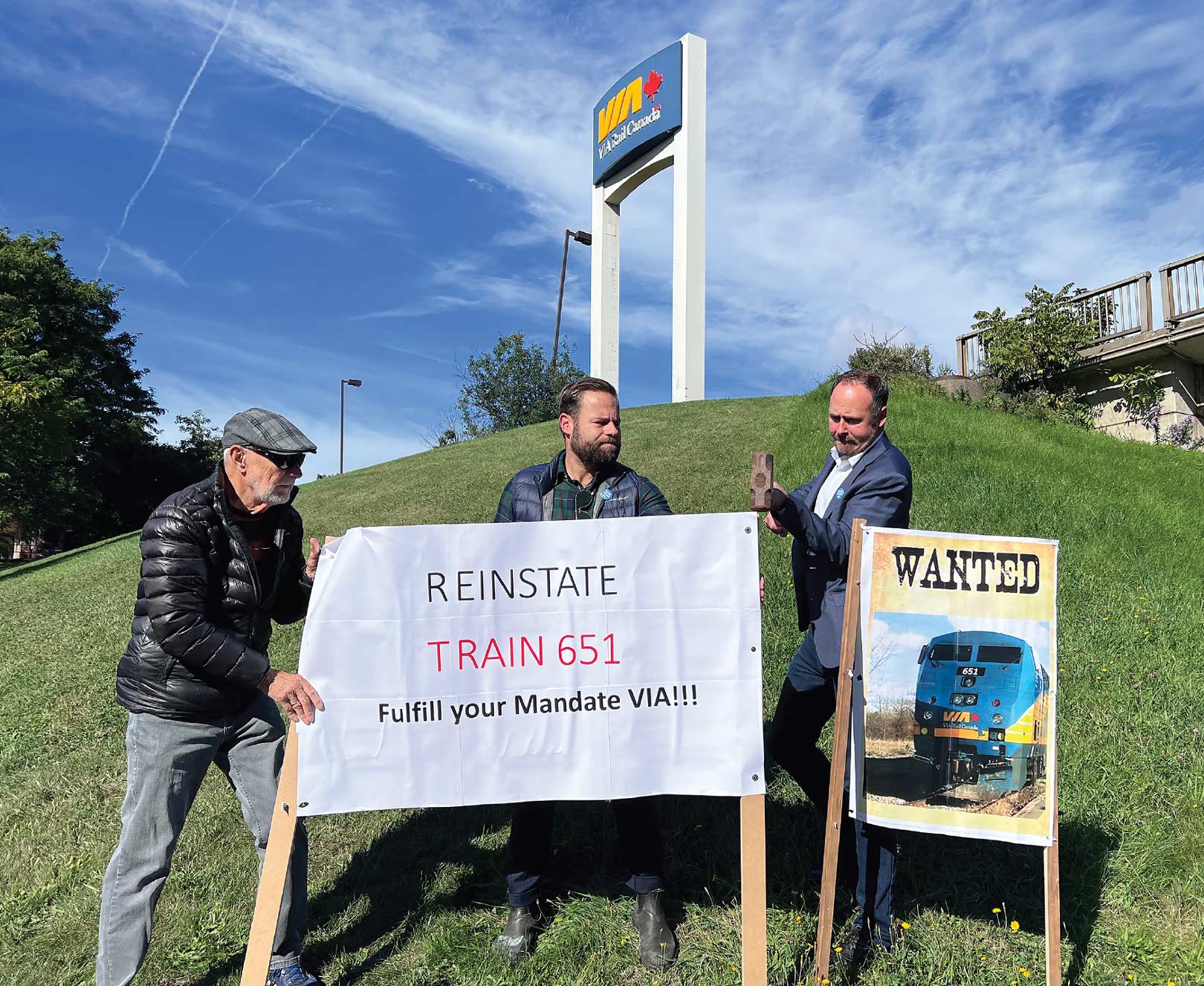

MPP Piccini (centre) and MP Lawrence (right) and concerned commuters organized a rally this past fall.

The once bustling Cobourg platform stands empty at 7a.m.; politicians, commuters and their families protest VIA's cancellation of Train 651.
Train 651 was more than a friendly, efficient and comfortable way to travel to and from Toronto – it was vital commuter transportation for hundreds. Will VIA Rail get itself back on track and revive this popular and necessary train?
You could hear the sputterings of commuter outrage ringing down the rails from Port Hope to Kingston as Martin Landry, CEO of VIA Rail, proclaimed, “We are definitely back on track … providing a safe, accessible, comfortable and sustainable travel experience to Canadians across the country.”
“We couldn’t be happier,” he said at the end of the summer, “as we had dearly missed our passengers.”
Dearly missed our passengers…
“Really?” the commuter chorus shouted back. “What about us? Where is our commuter train?” Most of VIA’s trains are back, but not Train 651, the early morning commuter train that picked up hundreds from Kingston, Belleville, Trenton, Cobourg and Port Hope and took them into Toronto to work every day. The train’s cancellation is a big and serious problem.
In pre-pandemic days, Train 651 – to commuters it was just “the train” – left Cobourg at 6:59 every morning, having left Kingston an hour earlier, and got commuters into Union Station in Toronto around 8:10. Hundreds of Eastern Ontario commuters streamed off the train and crossed the street to their Bay Street offices, went north on the subway, or walked up to hospital jobs on University Avenue. There was even a young man who unlocked his rented bicycle outside Union Station and pedalled off to the east end. And every afternoon those self-same men and women climbed back aboard the 5:30 (or if they had snuck out of work early, the 3:30), saved seats for each other, and watched for friends making a mad dash along the platform to jump through the doors at the last minute. And if they didn’t make the 5:30, they would be on the 6:30. The trains were not always on time – everyone lived with that – but the two trains in the morning and as many as four at night were vital. For many, the trains were a major reason families had moved out of the city to Port Hope and points east. Those commuters relied on VIA.
Not only was the train a practical option, it was comfortable and comforting. There were days when the sound of gentle snoring floated through the cars. The attendant pushed the cart along the aisle: “Your regular, Susan?” he’d ask, and hand over a little bottle of white wine. “Just a Diet Coke, for me today, Greg,” said the legal secretary sitting across the aisle. VIA commuters would climb off the train tired but content. No battling traffic, no watching the price of gas and Toronto parking. The train was a buffer between a long day’s work and home.
Train 651 was about more than just a commuter service. For many it had a major impact not only on those who made their living downtown, but also on students and on a good many people whose healthcare required treatment in one of the hospitals on University Avenue.
For many, VIA train 651 was a determining factor in their decision to move out of Toronto to points east.
BLAME COVID – BUT NOT FOREVER
Like much of VIA’s business, Train 651 disappeared with the pandemic. For two years the Cobourg and Port Hope commuters – plus a surprising number of early risers from Belleville, Trenton and Kingston – were locked down; and they turned into Zoom users, working from home and scrambling to maintain their health and keep their families safe. But when the Covid fog began to clear and companies called their employees back to work, VIA gradually restored service across the country. Too gradually. In Eastern Ontario, Train 41 – 8:15 out of Belleville, 8:51 out of Cobourg, getting into Toronto at 10:03 – came back; but that was as good as it got. Going into this winter it is still impossible to take the train into the city, put in a full day’s work, and be home for supper.
Kelly Calberry, a real estate law clerk from Port Hope, dug in her heels and convinced her law firm that she could do what she does just as effectively from home. Others fell victim to an across-the-board corporate policy that required them to clock into the office in Toronto in person at least two days a week; this despite a growing body of evidence that working from home was equally if not more productive. Elizabeth McDonald, an opera singer living in Prince Edward County, who taught music at the University of Toronto, used to get on the train in Trenton at 6:30 a.m. Now she cannot get to the university in time for her first class. Dianna Darwin, a nurse who reviews claims for the Workplace Safety and Insurance Board (WSIB), has had to beg the indulgence of her bosses. Like many others, she is trying to make the GO train out of Oshawa work for her. It’s more than a 45-minute drive to Oshawa from Cobourg where she lives; then there’s finding a parking spot and trekking across the asphalt to the station. Get there too late and there is no parking spot. Now she leaves Cobourg at 4:45 a.m., and where it used to take her an hour and a half to get to work, now it’s more than two and a half – that’s a daily commute of five hours.
Taking the train nowadays has also basically doubled in cost. Pre-pandemic there was a commuter pass that meant a return trip to Toronto cost around $37 from Cobourg; and provided there was space, passengers could change to a later train if work ran late. Now it’s more than $60 a day, minimum.
For opera singer Elizabeth McDonald, getting to work became overwhelming, and she has taken stress leave. Fortunately, she can afford the option. One man from Trenton has been called back in to work two days a week. He goes in one day, takes a hotel room and comes home at the end of the next day. His sense is that they will ask for three days inperson attendance soon. So far, he has fended off the demands of his employer by reassuring them that Train 651 will be back and he will be there again for early morning meetings. If 651 does not return, he is convinced he will be out on his ear – unemployed without the train. He is not the only one.
THE NUMBERS
Pre-pandemic commuters used to stand rows deep shivering on the platform every weekday winter’s morning in Cobourg and Port Hope. There were more from up the line and even commuters who got on VIA rather than the GO Train out of Oshawa. When Train 651 did not return in the spring or over the summer, complaints and concerns mounted. It became clear that there was a growing impact on the economy in the region. This was no longer merely a matter of convenience. Northumberland and Hastings County, together with the towns of Quinte West, Belleville and Kingston decided to come up with hard numbers to make their case to VIA and rescue their commuters. They sent out a survey, and more than 2,800 commuters responded: over 1,400 said they rode Train 651 and three quarters of those were on that early morning train one or more times a week.
What was also clear was that, contrary to popular thinking, people wanted to get back to in-person work. Ninety-six percent said they would be back on the train at a moment’s notice and an additional thirty-plus percent said they would become new riders if they had the chance.
Initially this area was a magnet for retirees; increasingly however, young families with parents who work in the city have been arriving. The commute was doable because of the train. There’s a lot at stake for a young family that has uprooted and moved out of the GTA. They came here relying on that VIA train. Promise broken.
Put the survey numbers together with higher than-provincial-average growth in both population and the labour force in Eastern Ontario, and the region could make a strong case to VIA in favour of bringing back that early morning commuter train – if only VIA would sit down and talk.
David Piccini, MPP for Northumberland-Peterborough South and Minister of the Environment, Conservation and Parks has been leading the political push for the restoration of service.
He is boiling over with frustration over VIA’s seeming lack of willingness to meet “eye to eye” about Train 651. According to Piccini, two meetings had been scheduled with VIA CEO Martin Landry. Both, Piccini says, were cancelled. He says his sense of urgency “was not matched by a semblance of care” on the part of VIA. It was a miasma of avoidance.
“WE WILL NOT BE DERAILED”
On a sunny Saturday sometime prior to the recent municipal elections, David Piccini organized a “Bring Back 651” rally on the grassy hillside outside the VIA station in Cobourg. Piccini, Conservative MP Philip Lawrence and fourteen municipal candidates from across the regions stood up on the hill, while Deputy Warden Mandy Martin from Colborne said “we will not be derailed.” Staff from Piccini’s office handed out “Save Train 651 Buttons.” Cars honked as they drove by on Division Street. Not only did frustrated commuters talk about the hard times they were facing getting to work, but one man spoke about the growing impossibility in getting to his medical appointments in Toronto. Piccini referred to the lawyers, entrepreneurs and young professionals who were missing Train 651.
More than one person talked about the safety hazards that come with that drive on the 401, which had become the only alternative route to work in Toronto. One law firm recently cited the 32 kilometres between Whitby and Courtice as the most dangerous stretch of highway in Ontario. Piccini referenced the environmental impact of putting that many more cars on the road every day. It’s impossible to come up with an exact number, but a safe estimate suggests that derailed VIA commuters now driving just from Cobourg to the Oshawa GO train station add 47 metric tonnes of CO2 emissions a day. That’s the equivalent of 25 million plastic straws. A little girl waved a sign that said, “My Mum needs 651,” and her brother’s sign read, “My Dad needs 651.” The cameras snapped and everyone cheered. It was a feel-good rally.
But was VIA listening?
Without train 651, commuters are faced with a daily drive on the 401 that includes one of the most dangerous stretches of highway in Ontario between Courtice and Whitby.
WHOSE RESPONSIBILITY?
In a one-on-one conversation a few weeks later, Piccini went into the complexities of the issue more deeply. “We’re not looking at 30s and 40s train nostalgia,” he said. “That’s not what this is about.” Rather, getting VIA back is merely one element in a comprehensive transportation plan that is, he said, at least as much about roads as about public transportation. They are not mutually exclusive.
Despite the heated discussion over the development of Highway 413 west of Toronto during the recent provincial election, Piccini notes that Doug Ford’s government has spent more on public transportation than any to date. A lot of that provincial money has gone and will go to the GO Train, the regional commuter train that runs from Kitchener to Oshawa and Barrie to Niagara Falls. The province funds GO, and the federal government funds VIA. Of course this is a political issue.
It comes down to who has the responsibility for commuter transportation in this region. Port Hope to Kingston is betwixt and between, neither fish nor fowl. Train 651 is seen by those who ride it and by local political leaders as a commuter train; but the word “commuter” does not appear anywhere in VIA’s 2021-2025 Corporate Plan. Rather VIA’s mandated responsibility is to service “regional and remote communities.” Port Hope, Cobourg, Belleville and Kingston might well be regional, but they are hardly remote communities.
Following the models of regional commuter transportation systems all over the world – networks radiating hundreds of miles out from London, New York, Paris, Milan and cities all over Asia – the towns closest to Toronto will eventually be folded into the province’s GO system. But when will that happen? Kathleen Wynne’s Liberal provincial government announced the extension of the GO train from Oshawa to Bowmanville, a distance of twenty kilometres, in 2016. The projection was that the Bowmanville extension would be up and running by 2024. Today, Piccini is proud that at least the work has started.
A safe estimate suggests that derailed VIA commuters now driving just from Cobourg to the Oshawa GO train station add 47 metric tonnes of CO2 emissions a day. That’s the equivalent of 25 million plastic straws.
If that extension were to be completed according to the initial projection, at a rate of 8 years for every 20 kilometres extension of the GO Train, it would be at least 2040 before the GO Train chugged into Cobourg. In the meantime there’s an on-demand GO bus now in operation, with all that implies in terms of traffic congestion, emissions and delays.
If GO is the way of the future, it’s a distant future. VIA remains an essential interim measure.
“NOT IN THIS CALENDAR YEAR”
In its most recent corporate report, VIA itself describes the Quebec City-to-Windsor corridor – of which Eastern Ontario is a key part – as the “most commercially viable” in the VIA empire with the “greatest potential for growth.”
CEO Martin Landry is credited with increasing VIA rail ridership by 32 percent in the five years leading up to the pandemic. VIA’s commuter service to Eastern Ontario sounds like a veritable gold mine. So what’s stopping the resumption of Train 651? VIA says a decision will be made about the future of Train 651 “sometime this fall.” David Piccini says he’s been told “service will not be restored in this calendar year.” Others with a purported inside track say there is an equipment shortage, an explanation that leaves most people shaking their heads. When Train 651 was on track, grumbling about VIA was almost a sport: the train was late, the reservation system didn’t work, the prices had gone up again. But at least it was there, and VIA finessed its relationship with its passengers.
There were Christmases when VIA’s CEO and a couple of underlings rode the train with the commuters from Toronto down the line east serving up canapés and sharing a drink. Goodwill prevailed, commuters were on a first-name basis with the men and women who made the trains run. Not anymore. Given all the factors that are obvious to anyone – environment, infrastructure, economics and changing demographics – shouldn’t commuting solutions be getting easier and more plentiful? Commuters could be forgiven for thinking that it’s the other way around.
The ball is in VIA’s court. Makeshift arrangements of carpools, the slog of winter driving, deadly traffic volume on the 401, and seriously impacted economic expansion are no-win situations in need of a solution that was already in place – before it was shunted to the sidings.
Story by:
Karin Wells



